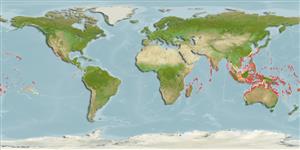>
Tetraodontiformes (Puffers and filefishes) >
Tetraodontidae (Puffers) > Canthigasterinae
Etymology: Canthigaster: Greek, kanthos = the outer or inner corner of the eye, where the lids meet, 1646 + Greek, gaster = stomach (Ref. 45335).
More on author: Bleeker.
Environment: milieu / climate zone / depth range / distribution range
Ökologie
seewasser riff-verbunden; tiefenbereich 1 - 30 m (Ref. 1602). Tropical; 32°N - 32°S
Indo-Pacific: East Africa south to Transkei, South Africa (Ref. 4919) and east to the Line, Marquesan, and Oeno islands, north to southern Japan, south to Lord Howe Island. Replaced by Canthigaster jactator in the Hawaiian Islands and Canthigaster punctatissimus in the tropical eastern Pacific (Ref. 37816). Also recorded from Southeast Atlantic.
Size / Gewicht / Alter
Maturity: Lm ? range ? - ? cm
Max length : 9.0 cm TL Männchen/unbestimmt; (Ref. 4919)
Rückenflossenstacheln (insgesamt): 0; Rückenflossenweichstrahlen (insgesamt): 9-10; Afterflossenstacheln 0; Afterflossenweichstrahlen: 9 - 10. Many white spots scattered on body (Ref. 559).
Occurs in clear lagoon and seaward reefs, Ref. 48637. Found with sponges at various depths (Ref. 48637). Prefers sheltered areas in the form of holes in dead and living corals. Solitary or paired. Feeds on sponges, polychaetes, filamentous algae and on smaller quantities of tunicates, crustaceans, echinoderms and corals.
Life cycle and mating behavior
Geschlechtsreife | Fortpflanzung | Ablaichen | Eier | Fecundity | Larven
Myers, R.F., 1991. Micronesian reef fishes. Second Ed. Coral Graphics, Barrigada, Guam. 298 p. (Ref. 1602)
IUCN Rote Liste Status (Ref. 130435)
Bedrohung für Menschen
Harmless
Nutzung durch Menschen
Aquarium: Kommerziell
Mehr Information
ReferenzenAquakulturAquakultur ProfilZuchtlinienGenetikElectrophoresesVererbbarkeitKrankheitenVerarbeitungNutrientsMass conversion
PartnerBilderStamps, Coins Misc.LauteCiguateraGeschwindigkeitSchwimmstilKiemenoberflächeOtolithsGehirngrößeSehfähigkeit
Tools
Zusatzinformationen
Download XML
Internet Quellen
Estimates based on models
Preferred temperature (Ref.
123201): 24.7 - 29.3, mean 28.3 °C (based on 2816 cells).
Phylogenetic diversity index (Ref.
82804): PD
50 = 0.5000 [Uniqueness, from 0.5 = low to 2.0 = high].
Bayesian length-weight: a=0.03631 (0.01554 - 0.08482), b=2.88 (2.69 - 3.07), in cm total length, based on LWR estimates for this Genus-body shape (Ref.
93245).
Trophic level (Ref.
69278): 3.1 ±0.32 se; based on food items.
Widerstandsfähigkeit (Ref.
120179): hoch, Verdopplung der Population dauert weniger als 15 Monate. (Preliminary K or Fecundity.).
Fishing Vulnerability (Ref.
59153): Low vulnerability (10 of 100).
Nutrients (Ref.
124155): Calcium = 137 [63, 348] mg/100g; Iron = 1.16 [0.55, 2.75] mg/100g; Protein = 18.1 [15.8, 20.3] %; Omega3 = 0.129 [0.059, 0.271] g/100g; Selenium = 36.3 [16.4, 86.4] μg/100g; VitaminA = 49.2 [12.7, 199.1] μg/100g; Zinc = 2 [1, 3] mg/100g (wet weight);
